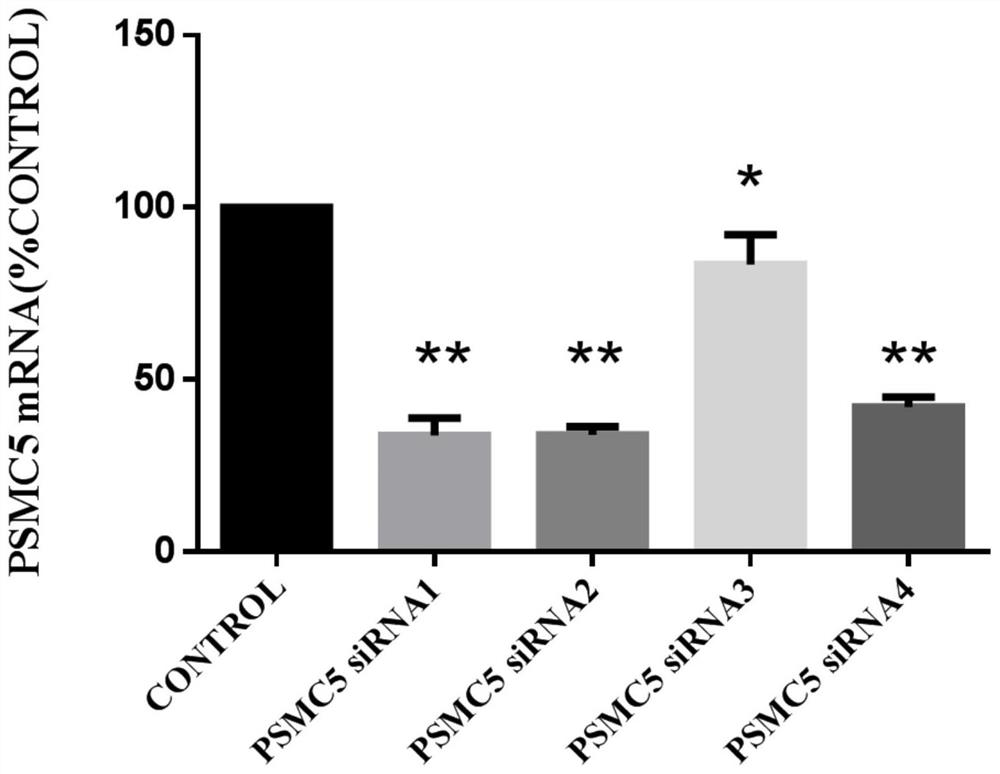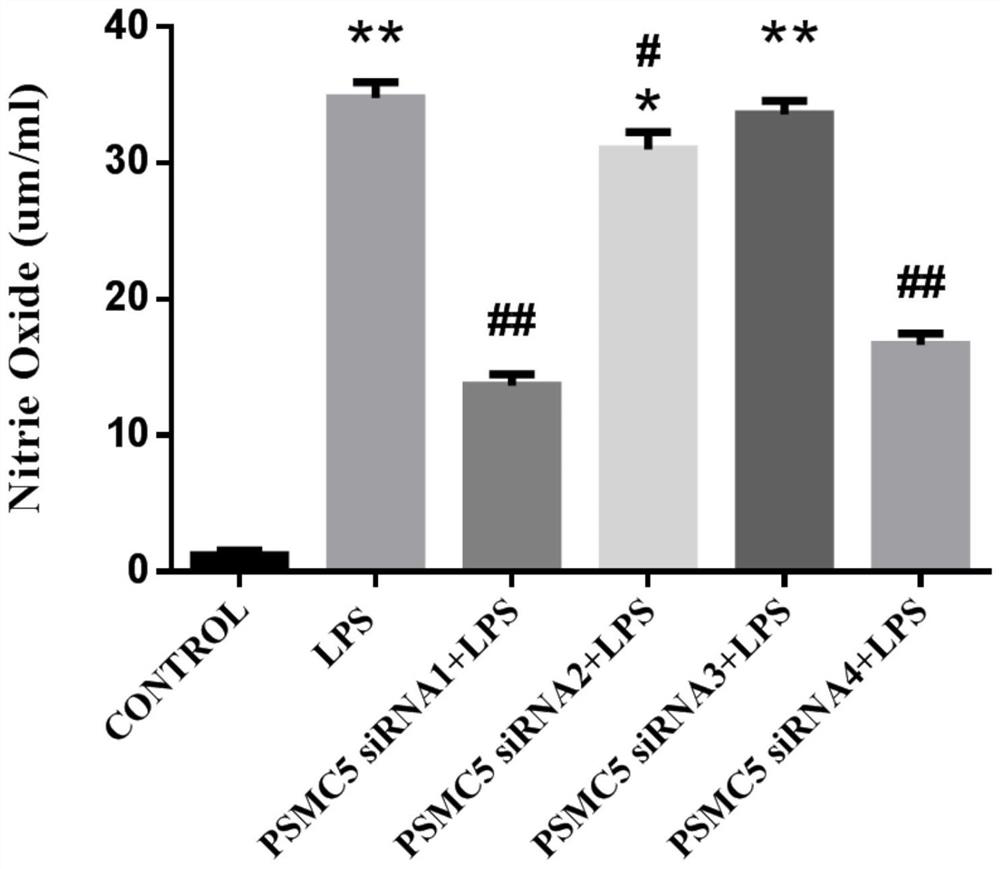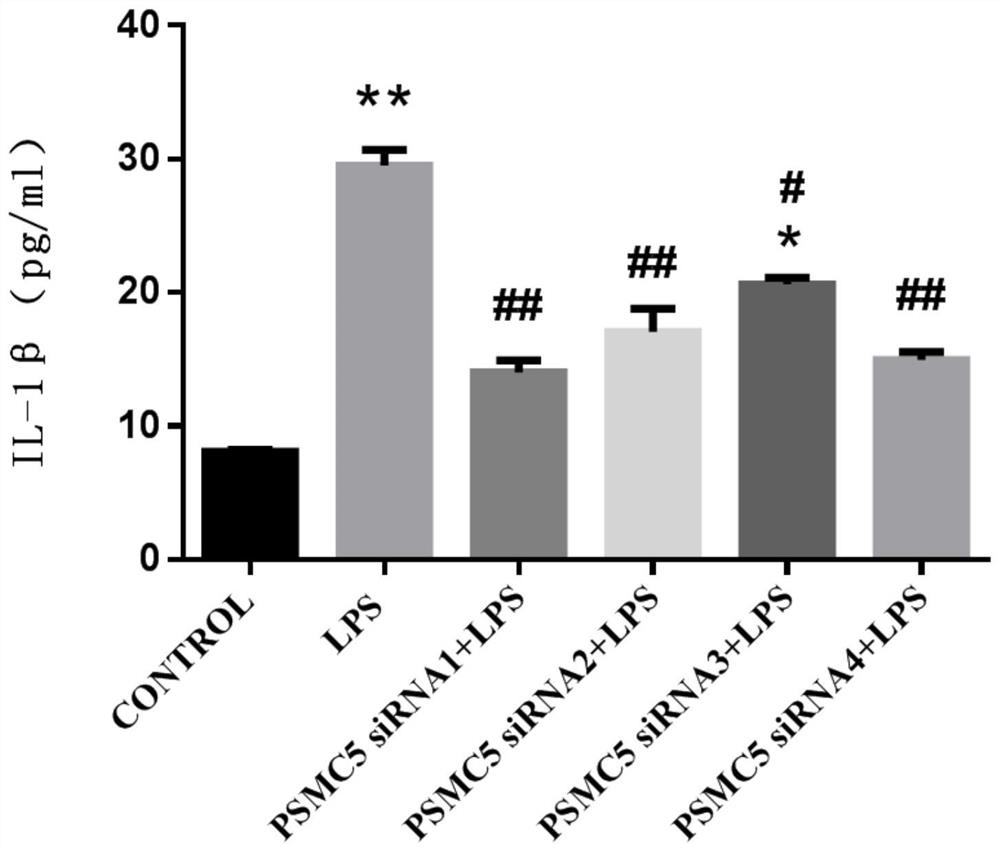siRNA targeting psmc5 gene and application of psmc5
A gene and targeting technology, applied in DNA/RNA fragments, genetic engineering, recombinant DNA technology, etc., to achieve significant interference effects, correct learning and memory, and regulate balance
- Summary
- Abstract
- Description
- Claims
- Application Information
AI Technical Summary
Problems solved by technology
Method used
Image
Examples
Embodiment 1
[0054] Example 1 Screening for the best sequence of efficient silencing of PSMC5 siRNA
[0055] The expression of PSMC5mRNA was detected by fluorescence quantitative PCR, and the interference efficiency was analyzed; the Griess reagent method was used to detect the NO in the supernatant of BV2 microglial cells (purchased from the Cell Resource Center of Peking Union Medical College, cell number: 3111C0001CCC000063) 2- The content of IL-1β in BV2 cell supernatant was determined by ELISA kit competition method, and the expression of PSMC5 protein in BV2 cells was detected by Western blot method, and the best interference sequence was screened out.
[0056] 1. BV2 cell culture
[0057] BV2 cells were cultured in complete DMEM medium containing 10% fetal bovine serum at 37°C, 5% CO 2 , cultured in a cell culture incubator under saturated humidity conditions.
[0058] 2. Selection, design and synthesis of PSMC5 siRNA targets
[0059] According to the known sequence of mouse PSMC...
Embodiment 2
[0092] Example 2 Establishment of AD Animal Model and Determination of PSMC5siRNA Treatment Dose and Time
[0093] C57 / 6J male mice aged 9-11 weeks were used, and lipopolysaccharide (Lipopolysaccharide, LPS) was injected intraperitoneally at 500 μg / kg or 750 μg / kg. The cognitive function of the mice was evaluated by the Morris water maze test and the dark avoidance test, and the motor coordination of the mice was detected by the rod climbing test.
[0094] 1. The effect of intraperitoneal injection of LPS on mouse positioning and navigation experiments and space exploration experiments
[0095] We set up the following groups and observed the latency to find the platform to evaluate the memory ability and spatial cognition ability of mice.
[0096] ①For the normal control group, normal saline (0.1 mL / 10 mg / d) was intraperitoneally administered for 7 consecutive days, and behavioral tests were performed 6 hours after administration.
[0097] ② LPS (500 μg / kg) group was adminis...
Embodiment 3
[0117] Example 3 PSMC5siRNA applied to activated BV2 microglial cells
[0118] 20 x 10 BV2 microglia 4 The cells / well were inoculated in 6-well plates, and the experiments were divided into the following five groups:
[0119] (1) Control group: no processing;
[0120] (2) LPS group: the concentration of LPS is 1000ng / mL;
[0121] (3) PSMC5siRNA+LPS group: transfected into PSMC5siRNA 1+LPS;
[0122] (4) NC+LPS group: negative control sequence PSMC5siRNA NC+LPS was transfected.
[0123] (5) NC group: transfect negative control sequence PSMC5siRNA NC.
[0124] The transfection method was the same as in Example 1.
[0125] The LPS-induced NO release from BV2 cells was detected by the Griess reagent method, and the specific operation steps and methods were the same as in Example 1.
[0126] The content of IL-1β, PGE2 and TNF-α in the cell supernatant was measured by enzyme-linked immunosorbent assay (ELISA): 20×10 BV2 microglial cells 4 Cells / well were seeded in 6-well plate...
PUM
 Login to View More
Login to View More Abstract
Description
Claims
Application Information
 Login to View More
Login to View More - R&D
- Intellectual Property
- Life Sciences
- Materials
- Tech Scout
- Unparalleled Data Quality
- Higher Quality Content
- 60% Fewer Hallucinations
Browse by: Latest US Patents, China's latest patents, Technical Efficacy Thesaurus, Application Domain, Technology Topic, Popular Technical Reports.
© 2025 PatSnap. All rights reserved.Legal|Privacy policy|Modern Slavery Act Transparency Statement|Sitemap|About US| Contact US: help@patsnap.com



